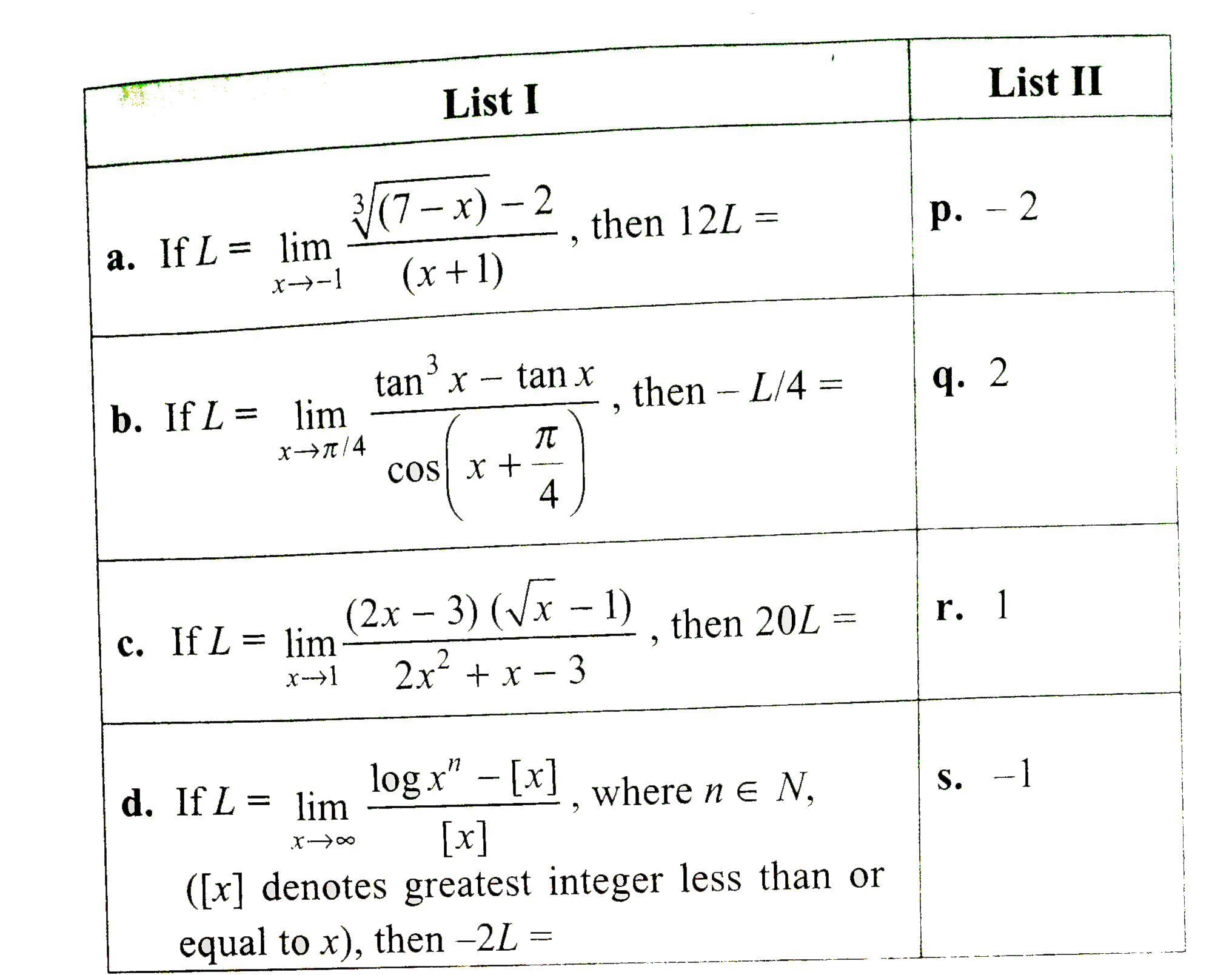If limx→∞f(x) exists and is finite and nonzero and if limx→∞{f(x)+3f(x)−1f2(x)}=3,then find the value of limx→∞f(x) Solution in Bengali
The correct Answer is:(1)
limx→∞(f(x)+3f(x)−1f2(x))=3
or ⎛⎜
⎜⎝limx→∞f(x)+3limx→∞f(x)−1(limx→∞f(x))2⎞⎟
⎟⎠=3
or (y+3y−1y2)=3
or y3−3y2+3y−1=0
or (y−1)3=0
or y=1
Topper's Solved these Questions
- BOOK - CENGAGE PUBLICATIONCHAPTER - LIMITSEXERCISE - Archives JEE MAIN8videos
LIMITS
- BOOK - CENGAGE PUBLICATIONCHAPTER - LIMITSEXERCISE - Archives JEE ADVANCED2videos
LIMITS
- BOOK - CENGAGE PUBLICATIONCHAPTER - LIMITSEXERCISE - Matrix Match Type5videos
LIMITS
- BOOK - CENGAGE PUBLICATIONCHAPTER - JEE 2019EXERCISE - Chapter 108videos
JEE 2019
- BOOK - CENGAGE PUBLICATIONCHAPTER - LINEAR COMBINATION OF VECTORS, DEPENDENT AND INDEPENDENT VECTORSEXERCISE - DPP 1.210videos
LINEAR COMBINATION OF VECTORS, DEPENDENT AND INDEPENDENT VECTORS
Similar Questions
Let f:R→R be a positive, increasing function with
limx→∞f(3x)f(x)=1. Then limx→∞f(2x)f(x) is equal to03:24View SolutionIf limx→0[1+xln(1+b2)]1x=2bsin2θ,b>0andθ∈(−π,π]. then the value of θ is
02:27View SolutionMatch the following lists:
 02:20View Solution
02:20View SolutionIf y = y(x) is the solution of the differential equation, xdydx+2y=x2 satisfying y(1) = 1, then y(12) is equal to
00:54View SolutionThe number of integral values of p for which (p+1)ˆi−3ˆj+pˆk,pˆi+(p+1)ˆj−3ˆk and −3ˆi+pˆj+(p+1)ˆk are linearly dependent vectors is q
04:42View SolutionIf lmx→∞f(x) exists and is finite and nonzero and if limx→∞{{f(x)+3f(x)−1f2(x)}=3,then the value of limx→∞f(x) is
01:51View SolutionIf lim_(x rarr oo)f(x) is finite and non zero and lim_(x rarr oo)(f(x)+((3f(x)+1)/(f^(2)(x)))=3 then find the value of lim_(x rarr oo)f(x)
02:02View Solutionf(x)=(ax^(2)+1)/(x^(2)+1),lim_(x rarr0)f(x)=1 and lim_(x rarr oo)f(x)=1, then prove that f(-2)=f(2)=1
01:47View SolutionIf f(x)=(x^(2))/(1+x^(2)), prove that lim_(x rarr oo)f(x)=1
03:45View SolutionLet f:R rarr[0,oo) be such that lim_(x rarr5)f(x) exists and lim_(x rarr5)([f(x)]^(2)-9)/(sqrt(|x-5|))=0 .then,lim_(x rarr6)f(x) equals to
00:57View SolutionIf alpha in(0,1) and f:R rarr R and lim_(x rarr oo)f(x)=0,lim_(x rarr oo)(f(x)-f(alpha x))/(x)=0 then lim_(x rarr oo)(f(x))/(x)=lambda where 2 lambda+7 is
02:52View SolutionLet f(x) is a differentiable function everywhere and suppose lim_(x rarr oo)(f'(x)+3f(x))=12 then lim_(x rarr oo)f(x) is equal to
03:57View SolutionLetf:R→R be a real function. The function f is double differentiable. If there exists n∈N and p∈R such that limx→∞xnf(x)=p and there exists limx→∞xn+1f(x),then
limx→∞xn+1f'(x) is equal to03:22View SolutionLetf:R→R be a real function. The function f is double differentiable. If there exists n∈N and p∈R such that limx→∞xnf(x)=p and there exists limx→∞xn+1f(x),then
limx→∞xn+2f''(x) is equal to03:03View Solutionlimx→∞(1+f(x))1f(x)
02:21View Solutionमाना की f:R→R एक धनात्मक वर्धमान फलन है जिसके लिए limx−∞f(3x)f(x)=1. तब limx−∞f(2x)f(x)=
03:26View Solution

